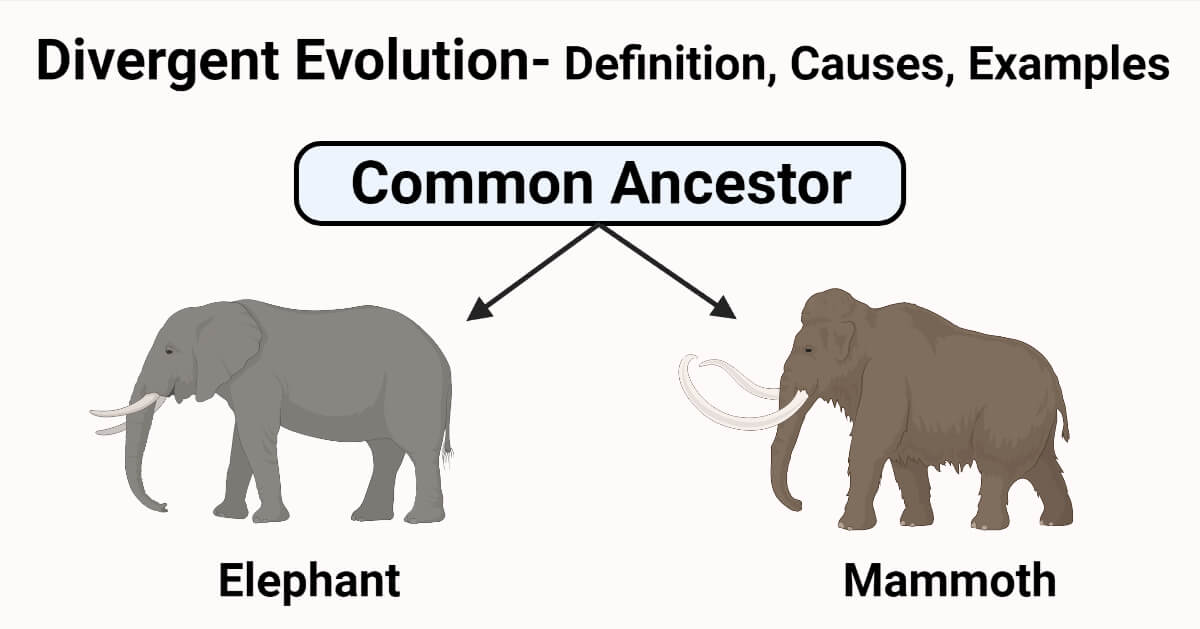Evolution refers to the series of gradual changes that can be observed in an organism from ancestors to predecessors in a longer period which can be genetic or phenotypic.
Evolution based on ancestors or origin and development of different structural and functional characters or traits can be divided into three main types:
- Convergent Evolution
- Divergent Evolution
- Parallel Evolution
What is Divergent Evolution?
Divergent evolution is a type of evolution that leads to varying functional developments or changes in similar basic structured organs of organisms belonging to a similar origin or similar ancestry.
Among the vertebrates from amphibians to mammals, the vertebrae, brain, eye, ears, and gut are constructed on the similar or same basic plan. Such homologous organs suggest common ancestry. In plants similarities in corolla, the morphology of cohesion or adhesion of stamens, venation suggest common ancestry. The plants developing in various habitats such as desert, plain areas, hills, and Himalaya bring out changes in their leaves, roots, venations, size of corolla based on their requirements such as nutrition, protection mechanisms, water, etc and hence develop homologous structures.
Adaptive radiation (i.e small-scale evolution occurring in a shorter period) leads to divergent evolution.
Divergence gives rise to speciation i.e variation in species arising from a common genus. It diverges towards dissimilarity giving rise to multiple evolutionary groups from a similar origin.
The organs or structures of species with similar origins in course of evolution develop a change in their functionality based on their adaptive habitat and are called homologous organs. Divergent evolution leads to homologous structures in organisms. Hence divergent evolution can also be called homologous evolution.
(Pneumonics: HD- Homologous and Divergent)
Structural, anatomical evidence, and palaeontological studies and comparisons let us learn about or determine evolutionary relations based on homology between different organisms.

Divergent Evolution Causes
- Alteration in environmental conditions in which the organisms live.
- Migration of organisms into different habitats.
- Different mechanisms of adaptations of the organisms for their survival.
- Genetic changes including mutations
Divergent Evolution Examples
- Variation in the forelimb structure of different vertebrates based on their different functions such as running in horses, flight in bats, walking and grasping in man, jumping in cats, etc.
- Darwin’s finches: Darwin discovered 14 species of finches on Galapagos island in which some were living in the ground but were seed-eaters, some were living on trees feeding on seeds, and some were living on trees but were insect eaters and according to their feeding habit they had developed different size and shape of beaks.
- Different primates such as lemurs, apes, monkeys, humans, etc. evolved from common ancestry.
- Fox, wolves, and dogs also evolved from a common ancestry according to their varying habitat.
- Another example is present elephants and extinct mammoths.
References
- Gautam P. (2020) Divergent Evolution. In: Vonk J., Shackelford T. (eds) Encyclopedia of Animal Cognition and Behavior. Springer, Cham. https://doi.org/10.1007/978-3-319-47829-6_501-1
- Losos, J. B., & Mahler, D. L. (2010). Adaptive radiation: The interaction of ecological opportunity, adaptation, and speciation. Evolution Since Darwin: The First, 150, 381–420.
- Mahato R.B. (2001) A Textbook of Biology. 5th edition. Ekta Books Distributors. Kathmandu Nepal pg. 358-399
